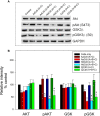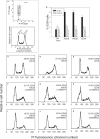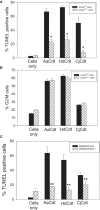The Active Subunit of the Cytolethal Distending Toxin, CdtB, Derived From Both Haemophilus ducreyi and Campylobacter jejuni Exhibits Potent Phosphatidylinositol-3,4,5-Triphosphate Phosphatase Activity
- PMID: 33854985
- PMCID: PMC8039388
- DOI: 10.3389/fcimb.2021.664221
The Active Subunit of the Cytolethal Distending Toxin, CdtB, Derived From Both Haemophilus ducreyi and Campylobacter jejuni Exhibits Potent Phosphatidylinositol-3,4,5-Triphosphate Phosphatase Activity
Abstract
Human lymphocytes exposed to Aggregatibacter actinomycetemcomitans (Aa) cytolethal distending toxin (Cdt) undergo cell cycle arrest and apoptosis. In previous studies, we demonstrated that the active Cdt subunit, CdtB, is a potent phosphatidylinositol (PI) 3,4,5-triphosphate phosphatase. Moreover, AaCdt-treated cells exhibit evidence of PI-3-kinase (PI-3K) signaling blockade characterized by reduced levels of PIP3, pAkt, and pGSK3β. We have also demonstrated that PI-3K blockade is a requisite of AaCdt-induced toxicity in lymphocytes. In this study, we extended our observations to include assessment of Cdts from Haemophilus ducreyi (HdCdt) and Campylobacter jejuni (CjCdt). We now report that the CdtB subunit from HdCdt and CjCdt, similar to that of AaCdt, exhibit potent PIP3 phosphatase activity and that Jurkat cells treated with these Cdts exhibit PI-3K signaling blockade: reduced levels of pAkt and pGSK3β. Since non-phosphorylated GSK3β is the active form of this kinase, we compared Cdts for dependence on GSK3β activity. Two GSK3β inhibitors were employed, LY2090314 and CHIR99021; both inhibitors blocked the ability of Cdts to induce cell cycle arrest. We have previously demonstrated that AaCdt induces increases in the CDK inhibitor, p21CIP1/WAF1, and, further, that this was a requisite for toxin-induced cell death via apoptosis. We now demonstrate that HdCdt and CjCdt also share this requirement. It is also noteworthy that p21CIP1/WAF1 was not involved in the ability of the three Cdts to induce cell cycle arrest. Finally, we demonstrate that, like AaCdt, HdCdt is dependent upon the host cell protein, cellugyrin, for its toxicity (and presumably internalization of CdtB); CjCdt was not dependent upon this protein. The implications of these findings as they relate to Cdt's molecular mode of action are discussed.
Keywords: apoptosis; cell cycle arrest; cytolethal distending toxin; host-parasite interactions; lymphocytes; pathogenesis; toxins.
Copyright © 2021 Huang, Boesze-Battaglia, Walker, Zekavat, Schaefer, Blanke and Shenker.
Conflict of interest statement
The authors declare that the research was conducted in the absence of any commercial or financial relationships that could be construed as a potential conflict of interest.
Figures







Similar articles
-
Aggregatibacter actinomycetemcomitans Cytolethal Distending Toxin-Induces Cell Cycle Arrest in a Glycogen Synthase Kinase (GSK)-3-Dependent Manner in Oral Keratinocytes.Int J Mol Sci. 2022 Oct 5;23(19):11831. doi: 10.3390/ijms231911831. Int J Mol Sci. 2022. PMID: 36233133 Free PMC article.
-
Lymphoid susceptibility to the Aggregatibacter actinomycetemcomitans cytolethal distending toxin is dependent upon baseline levels of the signaling lipid, phosphatidylinositol-3,4,5-triphosphate.Mol Oral Microbiol. 2016 Feb;31(1):33-42. doi: 10.1111/omi.12127. Epub 2015 Sep 24. Mol Oral Microbiol. 2016. PMID: 26299277 Free PMC article.
-
The toxicity of the Aggregatibacter actinomycetemcomitans cytolethal distending toxin correlates with its phosphatidylinositol-3,4,5-triphosphate phosphatase activity.Cell Microbiol. 2016 Feb;18(2):223-43. doi: 10.1111/cmi.12497. Epub 2015 Sep 2. Cell Microbiol. 2016. PMID: 26247396
-
A Journey of Cytolethal Distending Toxins through Cell Membranes.Front Cell Infect Microbiol. 2016 Aug 10;6:81. doi: 10.3389/fcimb.2016.00081. eCollection 2016. Front Cell Infect Microbiol. 2016. PMID: 27559534 Free PMC article. Review.
-
In vivo virulence properties of bacterial cytolethal-distending toxin.Cell Microbiol. 2008 Aug;10(8):1599-607. doi: 10.1111/j.1462-5822.2008.01173.x. Epub 2008 May 16. Cell Microbiol. 2008. PMID: 18489725 Review.
Cited by
-
Revisiting bacterial cytolethal distending toxin structure and function.Front Cell Infect Microbiol. 2023 Nov 14;13:1289359. doi: 10.3389/fcimb.2023.1289359. eCollection 2023. Front Cell Infect Microbiol. 2023. PMID: 38035327 Free PMC article.
-
Anti-cancer efficiency of Campylobacter jejuni secretome loaded chitosan nanoparticles on colorectal cancer signaling pathways.Cytotechnology. 2025 Jun;77(3):93. doi: 10.1007/s10616-025-00756-0. Epub 2025 Apr 28. Cytotechnology. 2025. PMID: 40309013
-
LRRC8A promotes Glaesserella parasuis cytolethal distending toxin-induced p53-dependent apoptosis in NPTr cells.Virulence. 2023 Dec;14(1):2287339. doi: 10.1080/21505594.2023.2287339. Epub 2023 Nov 29. Virulence. 2023. PMID: 38018865 Free PMC article.
-
Aggregatibacter actinomycetemcomitans cytolethal distending toxin modulates host phagocytic function.Front Cell Infect Microbiol. 2023 Aug 31;13:1220089. doi: 10.3389/fcimb.2023.1220089. eCollection 2023. Front Cell Infect Microbiol. 2023. PMID: 37719670 Free PMC article.
-
Campylobacter jejuni virulence factors: update on emerging issues and trends.J Biomed Sci. 2024 May 1;31(1):45. doi: 10.1186/s12929-024-01033-6. J Biomed Sci. 2024. PMID: 38693534 Free PMC article. Review.
References
-
- Boesze-Battaglia K., Besack D., McKay T., Zekavat A., Otis L., Jordan-Sciutto K., et al. . (2006). Cholesterol-rich membrane microdomains mediate cell cycle arrest induced by Actinobacillus actinomycetemcomitans cytolethal-distending toxin. Cell Microbiol. 8 (5), 823–836. 10.1111/j.1462-5822.2005.00669.x - DOI - PMC - PubMed
-
- Boesze-Battaglia K., Brown A., Walker L., Besack D., Zekavat A., Wrenn S., et al. . (2009). Cytolethal distending toxin-induced cell cycle arrest of lymphocytes is dependent upon recognition and binding to cholesterol. J. Biol. Chem. 284 (16), 10650–10658. 10.1074/jbc.M809094200 - DOI - PMC - PubMed
-
- Boesze-Battaglia K., Walker L. P., Zekavat A., Dlakic M., Scuron M. D., Nygren P., et al. . (2015). The Aggregatibacter actinomycetemcomitans Cytolethal Distending Toxin Active Subunit CdtB Contains a Cholesterol Recognition Sequence Required for Toxin Binding and Subunit Internalization. Infect. Immun. 83 (10), 4042–4055. 10.1128/IAI.00788-15 - DOI - PMC - PubMed
Publication types
MeSH terms
Substances
Grants and funding
LinkOut - more resources
Full Text Sources
Other Literature Sources
Research Materials
Miscellaneous

